Australia’s rental crisis is pushing aged care workers ‘out of their own communities’
Rental stress is affecting the aged care workers that are caring for older Australians
![<p>With rental costs increasing and some aged care workers struggling to find suitable accommodation, aged care homes may be at risk. [Source: Shutterstock]</p>](https://agedcareguide-assets.imgix.net/news/articles/wp/sadnurse1610.jpg?fm=pjpg&format=auto&w=550&q=65)
With rental costs increasing and some aged care workers struggling to find suitable accommodation, aged care homes may be at risk. [Source: Shutterstock]
Key points:
- Fewer than 1.5 percent of Australian rental properties are affordable for aged care workers, with housing in capital cities being the least affordable
- Aged care facilities across the country are facing nursing shortages in every part of the nation except for New South Wales and the Northern Territory
- Anglicare Australia Executive Director Kasy Chambers said the Australian rental market is ‘failing our key workers’ with a lack of affordable housing
Renting is now out of reach for many aged care workers, leading to further staffing issues and concerning older Australians who are trying to find suitable care.
Aged care workers and nurses can now afford fewer than 1.5 percent of rental properties and have reportedly faced housing-related stress, which may be why almost a third of aged care workers plan to leave the aged care industry by 2026.
Older Australians may think this will make it difficult to find an appropriate aged care facility for themselves or their loved ones, but using the Aged Care Guide’s search tool can remove the stress.
Renting a house in Australian capital cities is now $14,700 more on average, compared to four years ago, with renters of units also paying an average of $9,600 more per year.
While Hobart had the lowest average increase for units and houses in the country, the average increase of $42 dollars for units and $68 dollars for houses per week is significant for some aged care workers.
A level-one aged care home carer working full time will earn $28.94 per hour, equivalent to $1,099.72 dollars a week.
The average income of a full-time worker was $1,924.60 dollars per week in May 2024 according to the latest data from the Australian Bureau of Statistics.
Anglicare Australia Executive Director Kasy Chambers highlighted the impact of rental stress on aged care workers and how this could negatively affect aged care facilities across the country.
“It should be [a] national scandal that so few of our essential workers can afford to keep a roof over their head. […] More and more essential workers are being pushed into serious rental stress and pushed out of their own communities,” she said.
“Virtually no part of Australia is affordable for aged care workers, early childhood educators, cleaners, nurses and many other essential workers we rely on. It’s no wonder so many critical industries are facing worker shortages.
“It’s been clear for years now that the private rental market is failing people on low incomes. Now it’s clear that it’s also failing our key workers — including those who work full-time.”
A person’s occupation is defined as essential if ‘the person has specific skills, or is involved in the production of goods or the delivery of services, where the skills, goods or services are essential in responding to an emergency’ and includes aged care workers as they provide vital care to older Australians.
In a statement by Everybody’s Home, campaigners are concerned that ‘essential workers are increasingly being priced out of renting near their workplaces and the absence of these workers in our communities affects all of us.’
At least 18 aged care homes closed or were expected to close in 2023 because of staff shortages. However, older Australians can search for nursing home bed vacancies to ensure they receive the care they deserve.
Additionally, New South Wales and the Northern Territory don’t have registered shortages in the aged care nursing workforce, as per 2024 data from Jobs and Skills Australia.
Everybody’s Home spokesperson Maiy Azize highlighted the concerns of workers who cannot afford local accommodation and how this could impact services.
“[…] The steep rise in rents is pushing more people into severe housing stress and homelessness,” she said.
“Australians are being priced out of the cities where they work which can affect the liveability of our cities and the quality of essential services.”
However, approximately 370,000 people work in Australian aged care roles, including residential and home care.
Vacancies for residential permanent or respite care are available across Australia —learn more about current vacancies here:
Have you noticed staffing shortages in your aged care home or in-home services?
Let the team at Talking Aged Care know on social media.
For more information and news in the aged care industry, subscribe to our free newsletter.
Relevant content:
International Day of Older Persons to celebrate older Aussies and fight ageist stereotypes
Two-thirds of older Aussies are unprepared for bushfire season























